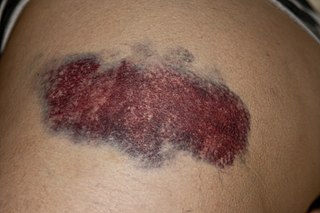
Erythema is redness of the skin or mucous membranes, caused by hyperemia in superficial capillaries. It occurs with any skin injury, infection, or inflammation. Examples of erythema not associated with pathology include nervous blushes.

A bruise, also known as a contusion, is a type of hematoma of tissue in which capillaries are damaged by trauma, causing a localized internal bleeding that extravasate into the surrounding interstitial tissues. Most bruises are not very deep under the skin so that the bleeding causes a visible discoloration. The bruise then remains visible until the blood is either absorbed by tissues or cleared by immune system action. Bruises, which do not blanch under pressure, can involve capillaries at the level of skin, subcutaneous tissue, muscle, or bone. Bruises are not to be confused with other similar-looking lesions primarily distinguished by their diameter or causation. These lesions include petechia, purpura, and ecchymosis.

Henoch–Schönlein purpura (HSP) is a disease of the skin, mucous membranes, and sometimes other organs that most commonly affects children. In the skin, the disease causes palpable purpura, often with joint pain and abdominal pain. With kidney involvement, there may be a loss of small amounts of blood and protein in the urine, but this usually goes unnoticed; in a small proportion of cases, the kidney involvement proceeds to chronic kidney disease. HSP is often preceded by an infection, such as a throat infection.

A petechia is a small (1–2 mm) red or purple spot on the skin, caused by a minor bleed from broken capillary blood vessels.
Purpura fulminans is an acute, often fatal, thrombotic disorder which manifests as blood spots, bruising and discolouration of the skin resulting from coagulation in small blood vessels within the skin and rapidly leads to skin necrosis and disseminated intravascular coagulation.

Schamberg's disease, is a chronic discoloration of the skin found in people of all ages, usually affecting the legs. It slowly spreads throughout the body, and is most common in males. It is named after Jay Frank Schamberg, who described it in 1901. There is no known cure for this disease and it is not a life-threatening condition. The skin lesions may cause itching, which can be treated by applying cortisone cream. The cortisone cream will only help with the itching and the discoloration of the skin will remain, which may cause a cosmetic concern in the future. Schamberg's disease is usually asymptomatic meaning that it shows no signs of this condition, except for the discoloration of the skin. This condition is caused by leaky blood vessels, where red blood cells escape near the surface of skin and release iron into the surrounding tissue. The cause of the leaky capillaries is unknown.

Amyloid purpura is a condition marked by bleeding under the skin (purpura) in some individuals with amyloidosis. Its cause is unknown, but coagulation defects caused by amyloid are thought to contribute.
Purpura of the nail beds usually result from trauma, with causes of toe involvement including physical pressure on the toes, such as that seen in surfboarding or windsurfing in which one must maintain balance with the toes, or when exogenous pressure is exerted from poorly fitting shoes. Purpura beneath the nails may present similar to a melanoma, a confusion that may result if the patient does not communicate the acuteness of onset.
Drug-induced thrombocytopenic purpura is a skin condition result from a low platelet count due to drug-induced anti-platelet antibodies caused by drugs such as heparin, sulfonamines, digoxin, quinine, and quinidine.
Cryoglobulinemic purpura is a skin condition characterized by purpura and occurring most frequently in multiple myeloma and macroglobulinemia.
Drug-induced purpura is a skin condition that may be related to platelet destruction, vessel fragility, interference with platelet function, or vasculitis.

Solar purpura is a skin condition characterized by large, sharply outlined, 1- to 5-cm, dark purplish-red ecchymoses appearing on the dorsa of the forearms and less often the hands.
Orthostatic purpura is a skin condition that results from prolonged standing or even sitting with the legs lowered, which produced edema and a purpuric eruption on the lower extremities.
Traumatic purpura is a skin condition resulting from trauma which produces ecchymoses of bizarre shapes suggestive of abuse.

Pigmented purpuric dermatosis refers to one of the three major classes of skin conditions characterized by purpuric skin eruptions.
Doucas and Kapetanakis pigmented purpura is a skin condition characterized by scaly and eczematous patches, which also have petechiae and hemosiderin staining.

Cutaneous small-vessel vasculitis, also known as hypersensitivity vasculitis, cutaneous leukocytoclastic vasculitis, hypersensitivity angiitis, cutaneous leukocytoclastic angiitis, cutaneous necrotizing vasculitis and cutaneous necrotizing venulitis, is inflammation of small blood vessels, characterized by palpable purpura. It is the most common vasculitis seen in clinical practice.
Acute hemorrhagic edema of infancy is a skin condition that affects children under the age of two with a recent history of upper respiratory illness, a course of antibiotics, or both. The disease was first described in 1938 by Finkelstein and later by Seidlmayer as "Seidlmayer cockade purpura".
Purpura haemorrhagica is a rare complication of equine strangles and is caused by bleeding from capillaries which results in red spots on the skin and mucous membranes together with oedema (swelling) of the limbs and the head. Purpura hemorrhagica is more common in younger animals.








